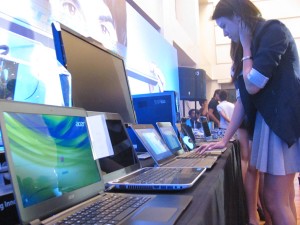Intel unveils faster, ‘higher density’ microprocessor
MANILA, Philippines – There is no better way to make nanotechnology cool than to put it in slim, sleek, and stylish computers.
International computer chip manufacturer Intel recently launched their latest microprocessor known as Ivy Bridge that is first in the world to be made using 22 nanometer 3-D tri-Gate transistor technology.
The 22 nanometer transistors are nearly as small as the Human Rhinovirus, responsible for the common cold, which is around 30 nanometers in size. In contrast, a single strand of human hair can be as small as 17,000 nanometers in diameter.
Smaller transistors mean a higher density in a single microchip and thereby increasing processing power while lowering energy consumption, Intel said in a statement released during the launch.
“The performance gains found in the new processors are due in part to the groundbreaking, three-dimensional structure of the new Intel transistors,” Intel said.
“Until today, computers, servers, and other devices have used only two-dimensional planar transistors. Adding a third dimension to transistors allows Intel to increase transistor density and put more capabilities into every square millimeter of the new processors,” Intel said.

Leighton Phillips, Intel Asia-Pacific Product Management Pricing Director, showcases Intels latest Ultrabook design powered by their newest processor, Ivy Bridge, that has 22 nanometer 3-D tri-gate transistors. Strategic Edge Inc./CONTRIBUTED PHOTO
The latest processors of Intel will power more than 100 Ultrabook designs that could be released in the market by next year, Leighton Phillips, Intel Asia-Pacific Product Management Pricing Director, said in an interview.
More than 35 of the designs are already available or will be out within the next 30 days, he added.
“If you look back at our first generation of Ultrabooks with the second generation of core microprocessors, we had 20 designs come to the marketplace,” Phillips said.
“For this third generation [microprocessor, there are] five times the number of designs, 100 designs of Ultrabook are being produced,” he said.
The new processor was said to increase a computer’s performance by 20 percent compared to computers last year. It will also improve the graphics capabilities of any computer, being able to deliver High Definition (HD) videos and 3-D graphics two times better.
“All the things people love to do on the PCs – from creating and editing videos and photos, surfing the web, watching HD movies or playing mainstream games – are now quicker, crisper,” Intel said.
The new processor will also have built-in security features to protect important data and information in the computer.
Intel’s Anti-Theft Technology allows an owner to completely shut down and disable the system of a computer when it is stolen so no one can use, just like an ATM card. Users who subscribe to the service will simply report that the computer is stolen and it will lockdown completely, protecting all data inside. Should the laptop be recovered by the user, a simple password will restore the computer back to normal.
Intel’s Identity Protection Technology secures users as they connect to the internet by making sure that it’s the actual user who is logging into sites and not any malicious software or virus.
Phillips said that the new processors will open new possibilities in the forms that the computer can take. Laptops could soon have touchscreens so that it can be convertible into a tablet by pulling the screen off, he said
“The best of the tablet and the best of the pc all in one,” he said about the possible future designs of computers.
